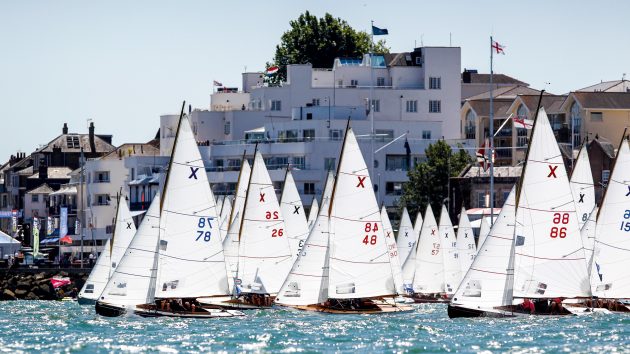Sailing different types of boats means you need to adapt your starting strategy. Ben McGrane explains some options to Andy Rice
Getting a good start is not just about being fast off the line in clear air. Sometimes the better start can be to wait in the second row near the committee boat and wait for your moment to tack off. Or it could even be to start on port tack behind the whole fleet.
So many of us have a favourite approach to the start that we try to make work for all occasions, but we need to be more adaptable than that. In faster planing or foiling boats, the port tack start can be a race-winning option but we’re looking at conventional starboard-tack starts for this article.
As multiple champion across a range of dinghy and keelboat classes, Ben McGrane is well placed to share his experience and advice on how to tailor your approach to different occasions and strategic scenarios. Here are Ben’s five best tips on starting strategically:
Pre-start prep
Launching out into clear air with a good lane at the start is only useful if it’s taking you in the right direction for your overall race strategy. If you start off the pin end of the line because there’s five degrees of line bias but you still can’t tack across to take advantage of the more favourable current on the right-hand side of the course, then your starting strategy was wrong. Deciding what kind of start you’re going to make will often go back to the morning of the race or sometimes even days or weeks before, if you’re planning for a venue with a strong gain feature.
On race day, be one of the first out on the course so you can start getting a sense of the conditions and logging your compass numbers on each tack.
Go middle (if quick)
If you’ve got good boatspeed you can afford to line up pretty much anywhere on the start line. If you’re less confident in your speed or you’re one of the slower boats in a handicap fleet, you’ve got to think a bit more carefully about where you position yourself.
The middle of the line presents opportunities if you’ve got a good transit on the land and you can take advantage of the midline sag. If it’s a shifty day, then the middle is a good place to start working the shifts from both sides of the course.

The iconic Rolex Middle Sea Race startline. Photo: Rolex/Kurt Arrigo
Pin end caution
Winning the pin is great when you make it happen, and it’s a great place to be assuming you want to go hard left up the beat. But you’re putting yourself in a situation where you’re working with limited options.
For anything other than a ‘go left’ beat, it’s a high-risk strategy. If you’re fast enough to pull out some distance to tack and cross the fleet, it’s a good option. But for most of us we have to be more careful about how and when we use the pin end option.
It’s also very dependent on what kind of boat you’re sailing and how long the first leg is. In a boat like a 505 that’s capable of planing upwind, you might get the jump on the boats around you. In displacement keelboats like the XOD it’s harder to get ahead of your rivals as the boat speed differences are marginal.
On a short course, making the pin end start work is going to be tricky because you’ll most likely run out of room before the layline. The longer the windward leg, the more time you have to make the pin end start work for you.
Get comfy at the committee boat
The benefit of starting near the committee boat is being able to get into phase with oscillating shifts. If the wind is consistently shifting 10° or 20°, starting at the boat can be powerful for you getting on to the lifted tack sooner than the boats further along the line who are waiting for others to tack first.
In a sea breeze scenario where you typically want to go right, starting near the committee boat is going to be a good option. And then there are current-driven venues or places like Lake Garda where you want to start at the committee boat and tack immediately on to port towards the cliffs. In those extreme scenarios it’s worth being second or even third row off the start, because getting on to port tack is your priority.
Have a backup plan
If your Plan A starting strategy doesn’t work out, what’s your Plan B? Inevitably some starts are going to go wrong. Either you don’t quite execute the acceleration off the line and you’re gasping for clear air, or you start too early and you have to go back to restart. Obviously if you’re starting in the middle it’s a long way back if you need to re-round the ends. A good recovery from a pin end start if you’re too early is to gybe around the pin mark and round up on port tack behind all the fleet on starboard.
Whatever your bailout after a bad start, the key thing is to remember to execute your original strategy, not to start gambling on an alternative.
 If you enjoyed this….
If you enjoyed this….
Yachting World is the world’s leading magazine for bluewater cruisers and offshore sailors. Every month we have inspirational adventures and practical features to help you realise your sailing dreams.Build your knowledge with a subscription delivered to your door. See our latest offers and save at least 30% off the cover price.





